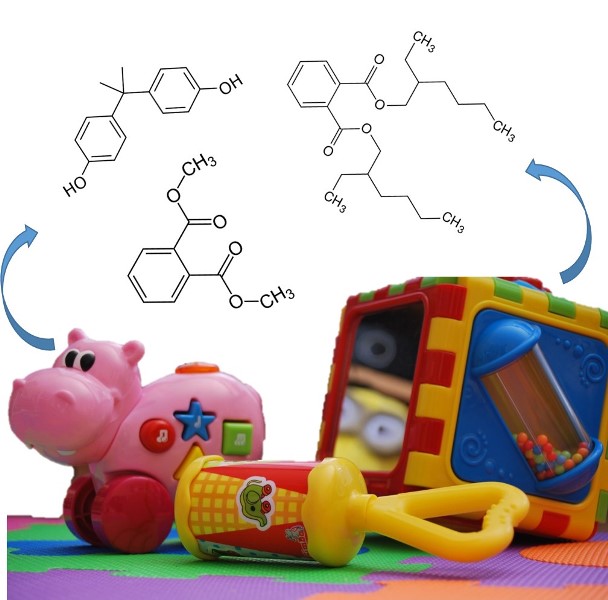Hazardous chemicals in children's toys

Plastic toys contain a large number of potentially hazardous chemicals. Image credit: Image edited by @emiliomoron, original from pxhere.com.
And as parents, how can we avoid toys that contain the most potentially harmful substances if there are no clear warnings on toy packaging? There is no consensus on toy labeling regulations, much less an agreement on which substances should be banned.
Worldwide, there is great concern that children's toys may contain harmful substances such as phthalate plasticizers, brominated flame retardants, colorants and metal-containing stabilizers, as several of these substances can pose a health risk, either individually or in combination. And although regulations exist in many countries to control the use of harmful substances in toys, they focus on the use of phthalates and brominated compounds, but there is no international consensus to globally control the use of potentially harmful substances in children's toys, nor do they cover the wide range of substances that can be found in such articles.
That is why researchers from DTU and the University of Michigan, along with UN Environment, have addressed this important issue and analyzed the chemicals found in plastic toys and quantified children's exposure, the study was recently published in the journal Environment International. The objective of the study was to develop an approach to examine the various chemicals found in plastic toys and identify potential chemicals of concern.
For the study, hard, soft and foam plastic toys were analyzed; and of the 419 substances found in these, 126 potentially harmful substances were identified, including 31 plasticizers in soft toys, 18 flame retardants and 8 fragrances, for this, the researchers gathered information on the composition of toys from chemical tests performed on specific toys and collected in 25 different peer-reviewed studies. In addition, the chemical emissions of these toys and the exposure of children were estimated using a series of models.

General structure of the phthalate molecule, a very dangerous substance used as a plasticizer. Image credit: wikipedia.com.
The researchers were able to establish that many of the substances found appear in some regulatory lists, however, they do not appear in others and that there are substances of concern that are not mentioned in any list.
Some of the chemicals of concern found in the study are as follows:

This study indicates that there is a significant amount of chemicals used in plastic toys that should trigger alerts, although the level of exposure is low, in the same study it was established that in Western countries children have an average of 18 kg of toys, which makes it evident that they are surrounded by plastic on a daily basis.
Undoubtedly, this is something that should concern the authorities with competence in the matter, since they should be properly alerted about the type of materials that children's toys are made of and encourage the substitution of these for safer and more sustainable substances. Although we cannot keep plastic toys away from our children, the best thing to do is to avoid their accumulation in the rooms where children sleep, frequently ventilate the places where they are stored and better avoid the use of soft plastic toys.
Thanks for coming by to read friends, I hope you liked the information. See you next time.

Greetings friend @emiliomoron
Excellent and very timely your publication, currently my youngest son is in permanent contact with this type of toys and it is very difficult for us not to let him play, but certainly the chemicals found in these plastic toys are dangerous, thanks for sharing this disturbing information, I will tell my wife these data that you expose. Best regards.
Greetings friend, no doubt it is very difficult for us parents not to allow our children to have plastic toys, we just have to be more cautious what kind of toys they have, hopefully the labels can be clearer about the warnings or in the near future all these substances will be replaced.
Very interesting, it is important to know these things, because those who are at risk are our children, greetings friend and thanks for your contribution.
Hi friend @carlos84, it really is important to know about this, to take the necessary precautions. Thanks to you for stopping by to read.
Plastic, despite its advantages, has been the most harmful invention for mankind, in fact not even nature degrades it easily.
I agree with you my friend, it has turned out to be a very useful and versatile material, but the damage it has caused to the environment has also been surprising.
Hi @emiliomoron
Very good post, it is important to highlight the risk to children's health due to the use of chemicals in plastic toys, a situation that is unknown or underestimated.
I share your opinion that the competent authorities, manufacturers and the general public should be informed and advised of the characteristics of the materials and their risks.
Thank you for the recommendations regarding the use and storage of soft plastic toys.
Have a good weekend,
Regards
Hi @raizayanez, thank you for your comment. Undoubtedly authorities and manufacturers must have an agreement on labeling and warnings about the substances present in plastic toys due to the important sector to which they are addressed, these investigations is good to know them to inform us about the potentially harmful substances present in articles of this type. Greetings!
Hello friend, excellent publication, the truth is an issue that few people talk about, but we should raise awareness of it. I think factories should do something about it and produce toys with other type of material, thinking about the health of the consumer or customer should always be the most important thing. Greetings!
Hello friend @franyeligonzalez. It really is an issue that we do not see discussed often, and it is something we should be aware of, I think there are many interests involved, the plastics industry is very large, hopefully studies like these drive movements that prioritize the health of the consumer. Greetings!
Greetings friend @emiliomoron.
As usual an excellent delivery that you share with us this time, it is important to always keep in mind the risks that can affect our children and especially related to their toys as they are in constant contact with them.
Thank you my friend for sharing such interesting content with all of us.
Saludos amigo @rbalzan, ciertamente es necesario estar atento a los riesgos a los cuales se pueden exponer nuestros niños, aunque provengan de un simple juguete, algo con lo que estan en contacto a diario. Gracias a ti por pasar a leer.
Greetings friend @rbalzan, it is certainly necessary to be aware of the risks to which our children can be exposed, even if they come from a simple toy, something with which they are in contact daily. Thanks to you for reading.
in the past toys had lead which is very toxic, nowadays big brands put labels to prevent possible incidents, on the other hand toys that come from countries like China do not have these quality controls and make the toys represent a potential danger for children, as parents we have to be more attentive to the origin of the toy.